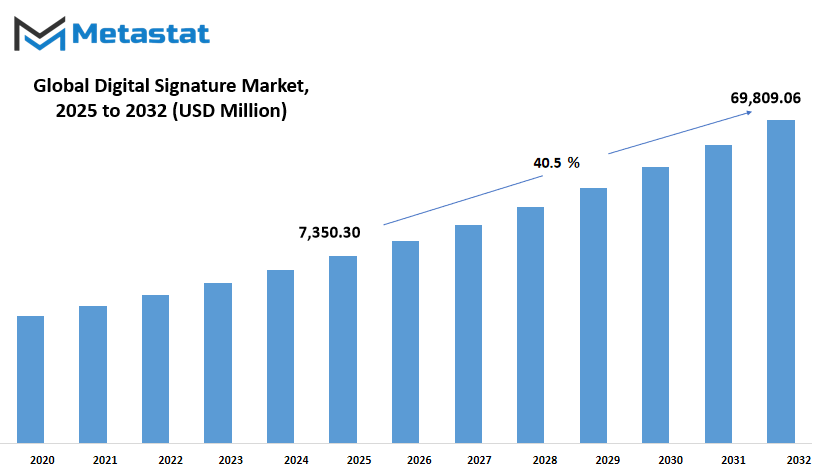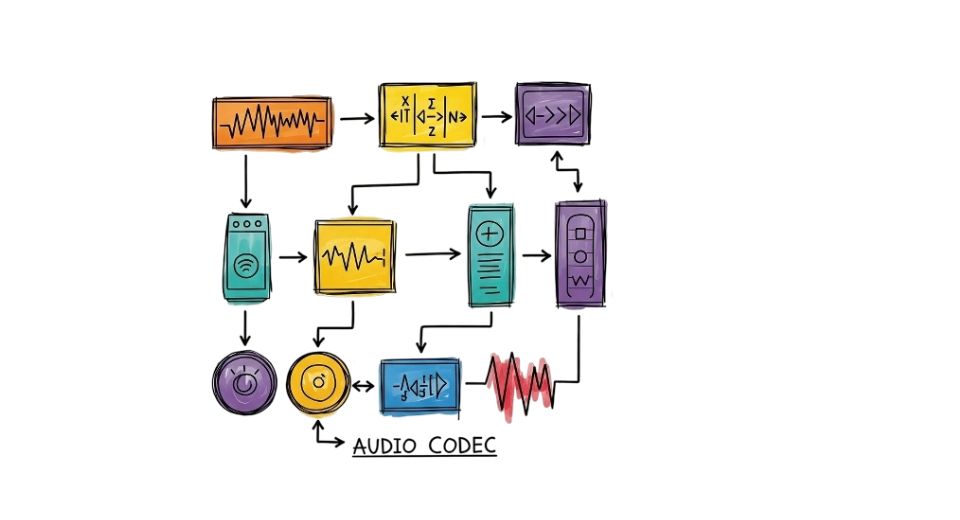MARKET OVERVIEW
The global digital signature market is a unique subsector of the broader cybersecurity and authentication marketplace. This market is focused on the technologies that enable companies and individuals to safely sign electronic documents and transactions with the guarantee of authenticity, integrity, and non-repudiation. As electronic interactions become an increasingly core aspect of both commercial and private transactions, this market will become increasingly important. Instead of being concentrated on software applications used to produce digital signatures, this market is a broader network of certificate authorities, encryption firms, cloud offerings, and legal technology consultants that as a whole facilitate secure digital communication.
Essentially, the global digital signature market is designed to break down inefficiencies of paper signatures for it to serve a need that is not merely convenience but security, legitimacy, and trust. These solutions will enable companies to execute agreements, contracts, and transactions across borders with the efficiencies and security of paperless documents. The market will derive its power in segments like banking, insurance, pharma, government, and education, where document security carries a money and legal value. It is not only confined to these sectors, but these will be most dependent on strong digital signature infrastructure.
The regulatory environment underpinning digital signatures will also change, dictating how and to what extent the global digital signature market will take place. Varying regions will need varying standards and levels of compliance, which will necessitate ongoing innovation and flexibility from service providers in this area. The validity of digital signatures relies in large part on the confidence they inspire in users, and that will be settled by the coherence and transparency of global regulatory reactions. That dynamic will drive the market toward solutions that provide safe technology as well as open routes to compliance and international acceptance.
One characteristic of this market will be its relationship with neighboring technologies. Blockchain, biometric authentication, and artificial intelligence will increasingly intersect with digital signature solutions, introducing additional security and sophistication. As they evolve, these technologies will influence the expectations and potential of digital signature software. The global digital signature market will not be an island unto itself; it will mirror increased technology changes and the increased value of cybersecurity in a world where intrusions into information and attempts at fraud become more advanced.
Second, the future of the market will likely enough see the change of user habits. Organizations will transition from considering digital signatures as an occasional utility to making them part of regular operations. This will shape product development, including ease of use interfaces, smooth integration with existing platforms, and proper support infrastructures in place. Vendors of this space must be able to envision emerging demands from businesses that will come to view digital signature capability as essential, not nicety.
The global digital signature market will be at the forefront of determining how trust is established in the digital space over the coming years. It will not just facilitate commerce but set the standards of security, authenticity, and efficiency in the digital space. This development will ensure that the market continues to be an integral part of the digital economy's infrastructure that forever evolves according to the legal, technological, and cultural spaces it caters to.
Global digital signature market is estimated to reach $69,809.06 Million by 2032; growing at a CAGR of 40.5% from 2025 to 2032.

GROWTH FACTORS
The global digital signature market is likely to witness steady growth in the future as more organizations around the world continue to shift towards paperless workflows. Many businesses and government bodies are now focused on reducing paperwork, which not only saves time and resources but also helps in promoting environmentally friendly practices. E-governance initiatives are gaining attention in several countries, aiming to improve transparency and efficiency in public services. These efforts strongly encourage the adoption of digital signatures as they help in verifying the authenticity of documents quickly and securely without the need for physical presence. This adoption will continue to rise as more industries recognize the convenience and security digital signatures provide.
One of the strongest reasons behind this market growth is the increasing pressure from regulatory bodies, especially in the banking and legal sectors. These industries handle highly sensitive information and are often targeted by fraud and cyber threats. Governments and regulatory authorities are setting stricter guidelines to ensure secure digital transactions, which has made the use of digital signatures more of a necessity than a choice. As these regulations become more common, organizations will be required to upgrade their systems to stay compliant, which will further boost the demand for digital signature solutions.
However, the market is not without its challenges. One of the major barriers is the high cost involved in the implementation of these solutions. For many organizations, especially smaller ones in developing regions, investing in advanced digital infrastructure can be financially overwhelming. On top of that, integrating modern digital signature systems with outdated legacy systems often leads to additional complications and expenses. These factors might slow down the market’s growth in some parts of the world.
Another key challenge is the lack of awareness and limited digital literacy among small and medium enterprises. In many developing regions, businesses still rely on traditional ways of handling documentation and are hesitant to trust digital solutions. Without proper knowledge about the benefits and security of digital signatures, these companies may delay their adoption, which could hold back the overall market potential.
Looking ahead, there are still significant opportunities for the global digital signature market. With the rise of hybrid work environments and the need for remote authentication, businesses will increasingly seek reliable solutions for secure digital onboarding and transactions. As more organizations understand the value of such technologies, and as costs potentially become more manageable, the demand for digital signature solutions is expected to rise steadily in the coming years.
MARKET SEGMENTATION
By Component
The global digital signature market is expected to grow steadily over the next several years as more businesses, governments, and individuals recognize the benefits of secure and fast digital transactions. This market is divided into three main components: hardware, software, and services. Each of these plays a key role in how digital signatures are adopted and used. Hardware includes physical devices such as signature pads or secure tokens that help protect the digital signature process. These tools ensure that users can sign documents safely without the risk of their identity being stolen. Although hardware is essential, its growth may be slightly slower compared to software and services because many organizations prefer solutions that require fewer physical components.
Software is perhaps the most flexible part of this market. It allows people to sign documents from almost any device, whether they are using a computer, tablet, or smartphone. The convenience of software solutions means they are likely to see the highest demand in the future. Companies developing digital signature software continue to focus on improving user experience, making it faster and simpler to add legally binding signatures to important documents. As more industries shift to digital operations, software solutions will remain a popular choice. These systems are also being integrated with other technologies, such as cloud storage and identity verification tools, which will make them even more appealing.
Services in the global digital signature market are also gaining importance. These services range from consulting and training to ongoing technical support. They help businesses implement digital signature solutions correctly and ensure they remain secure over time. Companies offering these services will likely expand as more organizations require guidance on legal and compliance issues tied to digital signatures. With regulations changing from one country to another, having access to expert advice can prevent costly mistakes and improve the overall efficiency of digital processes.
Looking ahead, the global digital signature market will continue to evolve alongside technological advancements. Businesses are expected to adopt more advanced security measures as cyber threats become more complex. This will drive further investment in hardware, software, and services. The future may also bring greater use of artificial intelligence to detect fraud and improve the reliability of digital signatures. With the growing need for safe, efficient, and legally accepted ways to handle digital transactions, this market is set to remain a key focus for companies and governments alike. The shift towards paperless processes will ensure that demand continues for all three components well into the future.
By Level
The global digital signature market is expected to experience significant growth in the coming years due to the rising need for secure and reliable methods of signing documents electronically. As technology continues to shape how people communicate and conduct business, the demand for digital solutions that can verify identity and ensure the authenticity of documents will only increase. Businesses and individuals want to protect their information and avoid fraud, which is why digital signatures are becoming a trusted solution. With regulations and compliance requirements becoming more strict in many parts of the world, companies are turning to digital signatures to meet these standards while also saving time and reducing paperwork.
By level, the global digital signature market is mainly divided into Advanced Electronic Signatures (AES) and Qualified Electronic Signatures (QES). Each of these plays an important role in how digital signatures are adopted and trusted. Advanced Electronic Signatures provide a higher level of security than basic electronic signatures by confirming the identity of the signer and detecting any changes made to the signed data. They are often used by companies that need to ensure the integrity of their transactions but may not require the highest legal standing in every case. On the other hand, Qualified Electronic Signatures offer the highest level of legal recognition and are equivalent to handwritten signatures in many countries. These are used in situations where strict verification and legal proof are necessary, such as in government documents, legal contracts, and financial agreements.
Looking ahead, the future of the global digital signature market will likely see even broader adoption as more sectors recognize the benefits of moving towards secure, digital workflows. Digital transformation is no longer a trend but a necessity, and digital signatures are a key part of this shift. Industries such as healthcare, banking, insurance, and legal services will increasingly depend on these solutions to enhance trust, improve efficiency, and reduce the risks associated with manual processes. Furthermore, as artificial intelligence and blockchain technologies continue to develop, digital signatures will become even more secure and harder to forge, providing additional peace of mind for users.
In conclusion, the global digital signature market will continue to evolve as the world becomes more connected and reliant on digital transactions. The need for secure, verifiable, and legally accepted signatures will drive the adoption of both Advanced Electronic Signatures and Qualified Electronic Signatures, shaping the way people do business in the future.
By Deployment
The global digital signature market is expected to grow steadily in the future as more businesses and organizations look for secure ways to verify documents and transactions. A digital signature is a type of electronic signature that uses encryption technology to ensure that a document has not been changed and comes from a trusted source. This technology is becoming more important as companies move away from paper-based processes and focus more on digital solutions. Governments, banks, healthcare providers, and legal institutions are among the key users of digital signatures. They rely on these solutions to protect sensitive information and meet regulatory requirements. As industries continue to move toward automation, the demand for trusted verification tools like digital signatures will increase.
The global digital signature market is divided by deployment type into Cloud and On-premise solutions. Cloud-based solutions are becoming more popular because they are easy to use and do not require heavy investments in hardware or IT staff. They allow businesses to access digital signature services from any location, which fits well with the rise of remote work and international collaboration. These services offer flexibility and are often updated automatically, which means companies can always rely on having the latest security features. On the other hand, some organizations still prefer On-premise solutions because they want full control over their data and security systems. These solutions are often chosen by industries that handle extremely sensitive information, such as defense or high-level government agencies.
Looking ahead, the future of the global digital signature market seems to be moving more towards cloud-based solutions. As technology continues to improve, cloud platforms will likely become even more secure and trusted, encouraging more companies to adopt them. However, On-premise solutions will not disappear completely. There will always be industries and organizations that need to manage their systems in-house due to strict security policies or legal reasons.
With the increase in cyber threats and data breaches, the importance of reliable digital signatures will only grow. New technologies like artificial intelligence may also play a role in making these solutions smarter, faster, and more secure. As businesses continue to expand across borders, digital signature tools will become even more valuable for ensuring trust and transparency in digital communications. The global digital signature market holds strong potential for both short-term and long-term growth as more people understand the need for secure and verified digital transactions. This shift towards safer digital practices will help shape the future of how businesses and governments operate worldwide.
By Industry Vertical
The global digital signature market is expected to see steady growth in the future, especially as more industries continue to adopt secure and reliable methods of verifying documents and transactions. Digital signatures have already proven to be an important tool for businesses and organizations looking to improve efficiency, security, and trust in their operations. As technology advances, this market will only become more essential in helping industries move forward with confidence.
By industry vertical, the global digital signature market is divided into several key sectors. These include BFSI, which stands for banking, financial services, and insurance. This sector has been one of the earliest adopters of digital signatures because of the strict security measures it requires. Digital signatures help banks and financial institutions protect sensitive information, verify customer identities, and ensure the accuracy of contracts and agreements. This not only reduces paperwork but also cuts down on fraud and errors.
Health care and life sciences are also increasingly using digital signatures. As medical records and health data are moved online, hospitals, clinics, and pharmaceutical companies are finding digital signatures a practical solution for protecting patient information. They also help in making the approval process for research and development faster and safer. In the future, this will play a bigger role in improving patient care and speeding up innovations in medicine.
The IT and telecom industries also make up a large part of the global digital signature market. These industries rely heavily on secure communication and data transfer, making digital signatures a natural choice. Companies in this space will continue to look for ways to improve security while offering seamless user experiences. Digital signatures will help them meet these goals as they expand their services and reach wider audiences.
Government bodies are adopting digital signatures as well. Many government offices are moving toward paperless systems, and digital signatures allow for more secure and efficient processing of everything from permits to tax documents. This adoption will likely grow, especially as more citizens expect faster and more reliable digital services.
Retail businesses are starting to embrace digital signatures too. They use them to protect contracts, manage supply chains, and handle customer agreements more securely. As online shopping and digital payments increase, this will become even more important.
Finally, other industries not specifically mentioned also contribute to the global digital signature market. These can include education, manufacturing, and legal services. Each of these sectors is recognizing the value of secure and efficient ways to handle important documents and transactions. In the future, this trend will continue to shape the market.
|
Forecast Period |
2025-2032 |
|
Market Size in 2025 |
$7,350.30 million |
|
Market Size by 2032 |
$69,809.06 Million |
|
Growth Rate from 2025 to 2032 |
40.5% |
|
Base Year |
2024 |
|
Regions Covered |
North America, Europe, Asia-Pacific Green, South America, Middle East & Africa |
REGIONAL ANALYSIS
The global digital signature market is expected to witness continuous growth in the years ahead as businesses and governments increasingly prioritize security and efficiency in their digital processes. Digital signatures help verify the authenticity of electronic documents, offering a secure and legally recognized way of confirming identities and approvals. This has become especially important as more transactions, communications, and official records move online. In the future, this market will likely become a critical foundation for how contracts, agreements, and communications are handled around the world.
Geographically, the global digital signature market is split into several key regions, each contributing in different ways to its development and growth. North America is one of the most advanced regions in terms of adopting digital signature technologies. The United States, Canada, and Mexico are leading the way due to strong regulations around data security and increasing demand from sectors like banking, healthcare, and government. Companies in these countries are investing heavily in digital solutions to streamline operations, cut costs, and protect sensitive information.
In Europe, countries such as the UK, Germany, France, and Italy are seeing a steady rise in digital signature usage. This is largely because of strict data protection laws like GDPR and the growing need for secure digital interactions across various industries. European businesses and governments are focusing on solutions that help reduce paperwork and improve digital trust among users. As people become more comfortable with digital tools, the demand will only rise.
Asia-Pacific represents one of the fastest-growing regions for the global digital signature market. Nations like India, China, Japan, and South Korea are investing in digital infrastructure and cybersecurity, recognizing the need for secure digital identities in both the public and private sectors. These countries are expected to drive innovation and expand the market significantly in the coming years as they push for more digital government services, e-commerce platforms, and secure financial transactions.
South America, with Brazil and Argentina at the forefront, is slowly catching up as awareness grows about the benefits of digital signatures. Companies here are beginning to understand how digital tools can simplify business processes and enhance trust in digital communications. Meanwhile, in the Middle East and Africa, regions such as the GCC Countries, Egypt, and South Africa are laying down frameworks that will help support growth in this area. Governments are pushing digital transformation agendas that will likely open new opportunities for digital signature solutions in the future.

COMPETITIVE PLAYERS
The global digital signature market will continue to witness significant developments as technology progresses and businesses seek more secure and efficient ways to operate. Digital signatures have already transformed how organizations handle agreements, authentication, and data security, but their role will expand even further in the future. As companies shift more towards digital platforms, the need for reliable solutions that guarantee authenticity and reduce fraud will grow. Businesses and governments will prioritize technologies that ensure transactions are both secure and legally recognized across borders.
One of the reasons the global digital signature market will advance is because of the increasing awareness among organizations about cybersecurity risks. Companies are no longer willing to depend on outdated systems that are prone to manipulation. Instead, they will invest in tools that not only protect data but also streamline processes. Digital signatures answer this need by offering encryption, verification, and protection in one solution. With the spread of remote work and the rise of digital communications, these tools will become even more necessary.
Key players driving this market’s future include Docusign, Inc., SIGNiX, Inc., Adobe Inc., OneSpan Inc., GlobalSign, IdenTrust, Inc., Thales Group, Visma, Ascertia, Topaz Systems, Inc., Entrust Corporation, Penneo, and Symtrax. These companies are already known for their strong positions in the market, and they will continue to shape its growth through innovation and strategic partnerships. Their focus will likely remain on enhancing user experience, strengthening security features, and expanding compliance with global regulations.
Competition among these players will push the boundaries of technology further. For example, advancements in biometric verification and blockchain integration will create more secure and transparent solutions. Companies will work to develop systems that are faster and easier to use, appealing to businesses of all sizes. The emphasis will shift toward creating solutions that not only meet the needs of large corporations but also small and medium enterprises looking for affordable and trustworthy options.
In the coming years, the global digital signature market will not only be about providing a signature but about offering a complete, trusted digital identity solution. As industries from finance to healthcare adopt these technologies, the demand will increase, encouraging players to innovate further. This growth will lead to more opportunities, partnerships, and investments aimed at staying competitive in a market that values trust, security, and efficiency. The companies involved will continue to shape this future through their commitment to advancing digital signature technologies.
Digital Signature Market Key Segments:
By Component
- Hardware
- Software
- Services
By Level
- Advanced Electronic Signatures (AES)
- Qualified Electronic Signatures (QES)
By Deployment
- Cloud
- On-premise
By Industry Vertical
- BFSI
- Health Care & Life Science
- IT & Telecom
- Government
- Retail
- Others
Key Global Digital Signature Industry Players
- Docusign, Inc.
- SIGNiX, Inc.
- Adobe Inc.
- OneSpan Inc.
- GlobalSign
- IdenTrust, Inc.
- Thales Group
- Visma
- Ascertia
- Topaz Systems, Inc.
- Entrust Corporation
- Penneo
- Symtrax
WHAT REPORT PROVIDES
- Full in-depth analysis of the parent Industry
- Important changes in market and its dynamics
- Segmentation details of the market
- Former, on-going, and projected market analysis in terms of volume and value
- Assessment of niche industry developments
- Market share analysis
- Key strategies of major players
- Emerging segments and regional growth potential








 US: +1 3023308252
US: +1 3023308252






